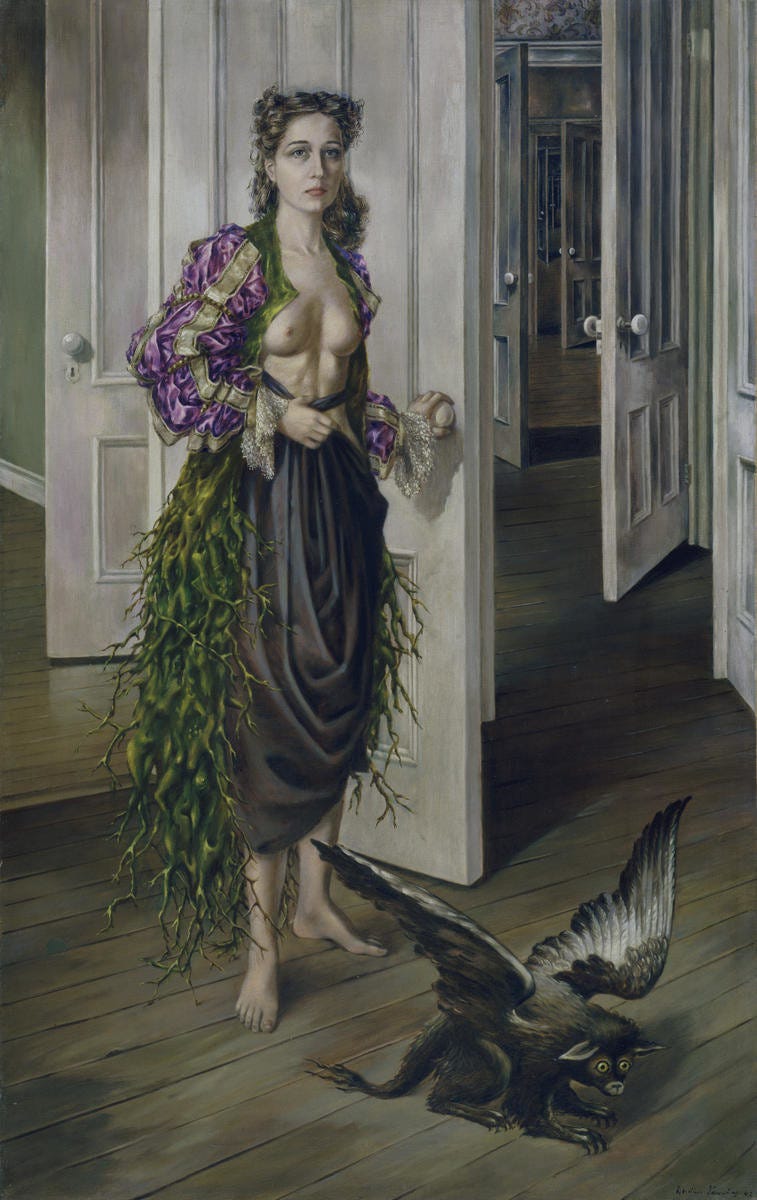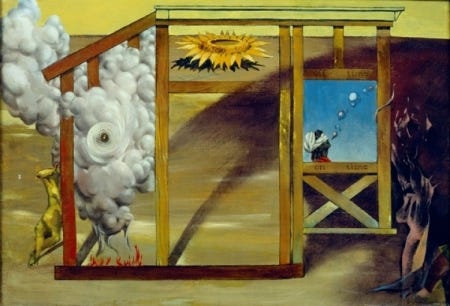
Dorothea Tanning (1910–2012) remains one of the most compelling and complex figures in Surrealist art. Born in 1910 in the United States, Tanning embarked on an artistic journey that spanned nearly a century, engaging in painting, sculpture, writing, and illustration. Her work is characterized by a persistent exploration of the unconscious, the interplay of dream and reality, and a rich personal symbolism that challenges conventional aesthetics. Tanning not only embraced the tenets of Surrealism, such as the liberation of the subconscious and the exploration of irrational imagery, but also expanded its discourse by integrating feminist insights and autobiographical elements into her art (Tate; The Art Story).
Dorothea Tanning’s early years were instrumental in shaping her creative vision. Raised in a middle-class family in Illinois, she received early training in painting and design in Chicago, which laid the technical and imaginative groundwork for her future endeavors. The cultural shifts of early twentieth-century America provided a fertile environment for artistic experimentation.
In the 1930s, Tanning’s relocation to Europe marked a turning point. Settling in Paris during the vibrant interwar period, she immersed herself in a thriving community of avant-garde artists. Here, the ideological and aesthetic innovations of the Surrealists, led by figures such as André Breton and Max Ernst, had a profound impact on her work. In this cosmopolitan milieu, Tanning began to experiment with dreamlike narratives and symbolic imagery, setting the stage for a career that would blur the lines between personal myth and collective cultural narratives (Oxford Art Online). The intersection of her American roots and European influences allowed her to develop a unique voice that would later be celebrated for its originality and emotional depth.

Surrealism, defined by its emphasis on the exploration of the unconscious mind and the liberation of the irrational, provided Tanning with an expressive framework that resonated deeply with her personal experiences. Her early exposure to Surrealist ideas enabled her to explore themes that were often considered taboo or inaccessible in conventional art circles. Works such as Birthday (1942) exemplify her method of using enigmatic, dreamlike imagery to investigate the complexities of human sexuality, identity, and time.
Unlike many of her male contemporaries, Tanning’s approach to Surrealism was uniquely introspective. She infused her canvases with a subtle feminist sensibility, interrogating the societal constraints placed on women and challenging traditional gender roles. Her art became a medium through which she expressed not only the irrationality of dreams but also the psychological and emotional realities of being a woman in a patriarchal society (The New York Times; MoMA). Tanning’s innovative blend of personal narrative and Surrealist theory contributed to a richer, more inclusive understanding of the movement’s potential.

Tanning’s oeuvre is notable for its bold thematic explorations and formal innovations. One of the most striking aspects of her work is the way she juxtaposes the familiar with the fantastical. Her paintings frequently feature domestic settings, spaces typically associated with comfort and safety, that are disrupted by surreal, often unsettling elements. This technique invites viewers to reconsider their perceptions of everyday life, suggesting that the ordinary can harbor extraordinary depths.
Her stylistic experiments extended beyond traditional painting techniques. Tanning was one of the pioneers in blending painting with sculptural and mixed-media elements, creating works that defied easy categorization. By incorporating collage, assemblage, and three-dimensional forms, she expanded the expressive potential of Surrealist art. Critics have noted that her art possesses a lyrical, almost narrative quality that mirrors the structure of a dream; fluid, ambiguous, and open to multiple interpretations (The Art Story; Tate).

Moreover, Tanning’s work is imbued with a recurring symbolism that reflects her lifelong engagement with themes of desire, transformation, and the passage of time. Her use of recurring motifs, such as organic forms, shadowy figures, and ambiguous spaces, creates a visual language that is both deeply personal and universally resonant. These innovations not only expanded the formal vocabulary of Surrealism but also anticipated later developments in contemporary art, particularly in the realms of feminist and psychoanalytic theory.
The impact of Dorothea Tanning’s work extends well beyond her direct involvement in the Surrealist movement. Her fearless exploration of the subconscious and her innovative use of form and symbolism have left an indelible mark on successive generations of artists. Tanning’s work has been featured in numerous retrospective exhibitions at leading institutions such as MoMA, Tate Modern, and the Whitney Museum, reinforcing her status as a seminal figure in twentieth-century art (MoMA; The Guardian).

Scholars and critics have increasingly recognized the importance of Tanning’s contributions to discussions on gender, identity, and the nature of artistic expression. Her work challenges the historical narratives that have traditionally marginalized female voices in modern art, and it offers an alternative perspective that is as intellectually rigorous as it is emotionally engaging. Contemporary artists continue to draw inspiration from her innovative approach to blending personal experience with broader cultural commentary (Oxford Art Online).
Tanning’s legacy is also evident in the way her art continues to provoke debate and inspire reinterpretation. In academic circles, her work is frequently cited as a bridge between early Surrealism and later movements such as feminist art and postmodernism. Her influence is not confined to the visual arts; her writings and personal reflections have contributed to a broader cultural dialogue about the role of art in understanding human experience. As new generations discover her work, Dorothea Tanning remains a vital and dynamic presence in the ongoing evolution of modern art.
Dorothea Tanning’s artistic journey is a testament to the transformative power of Surrealism and the enduring potential of personal expression. Her innovative blending of form, content, and symbolism created a body of work that not only captured the spirit of her time but also anticipated future debates in art and culture. By intertwining personal narrative with broader theoretical concerns, Tanning redefined the possibilities of artistic expression and expanded the boundaries of Surrealism. Today, her legacy lives on through the continued resonance of her imagery and the ongoing scholarly engagement with her work. Her contributions remind us that art is not merely a reflection of reality but a powerful means of reimagining it.
References:
Dorothea Tanning. The Art Story, www.theartstory.org/artist/tanning-dorothea/. Accessed 18 Jan. 2025.
Dorothea Tanning. Tate, www.tate.org.uk/art/artists/dorothea-tanning-2267. Accessed 18 Jan. 2025.
Dorothea Tanning, American Surrealist Painter, Dies at 101. The New York Times, 29 Nov. 2012, www.nytimes.com/2012/11/30/arts/dorothea-tanning-surrealist-painter-dies-at-101.html. Accessed 18 Jan. 2025.
Dorothea Tanning obituary. The Guardian, 1 Dec. 2012, www.theguardian.com/artanddesign/2012/dec/04/dorothea-tanning. Accessed 18 Jan. 2025.
Dorothea Tanning (1910–2012). Oxford Art Online, Oxford University Press, Accessed 18 Jan. 2025.
Dorothea Tanning: Surrealist Vision and the American Experience. MoMA, Museum of Modern Art, www.moma.org/artists/4402. Accessed 18 Jan. 2025.




There is the sense that one of the dressers Dali’s paintings opened a drawer and these little bits and creatures came dancing out of them onto her canvases.
Or maybe I’m just very very tired. And this is all a dream…
One of the “peripheral” figures of Surrealism who continues to fascinate in her own particular way, while many of the main figures have become a little too analysed and seen in recent decades . The consistent quality I have always associated with her work is that semblance of access to one of those very important and archetypal dreams. A very special painter. Well worth exploring more .